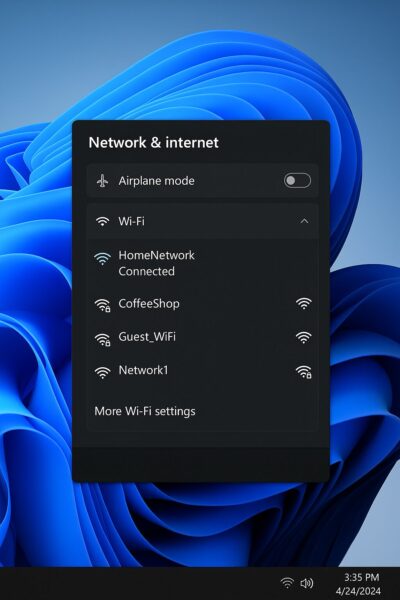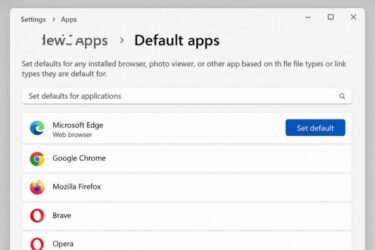
Getting your PC online is one of the first things you’ll want to do after setting up Windows 11. Without Wi-Fi, you can’t browse the web, watch videos, join online meetings, or download apps. Fortunately, connecting to a wireless network is quick and easy — even if you’ve never done it before.
This beginner’s guide will walk you through the process step by step, show you how to fix common connection issues, and share a few tips to make your Wi-Fi faster and safer.
1. Check If Your PC Has Wi-Fi Capability
Before you try connecting, make sure your PC actually supports Wi-Fi:
- Laptops: Almost all modern laptops have built-in Wi-Fi adapters.
- Desktops: Some have Wi-Fi built-in, but many rely on Ethernet (wired connection) unless you install a Wi-Fi card or use a USB Wi-Fi adapter.
💡 Tip
If your desktop doesn’t have Wi-Fi, you can get a USB Wi-Fi adapter — just plug it into a USB port, install any required drivers, and you’re ready to connect.
[affiliate links]
🔗 Check USB Wi-Fi adapters on Amazon
2. How to Connect to Wi-Fi in Windows 11
Follow these steps to connect to a wireless network:
- Click the Network icon in the taskbar (bottom-right corner of the screen).
- This icon looks like a set of wireless signal bars or a globe.
- Select your Wi-Fi network name (SSID) from the list.
- If you’re not sure which one is yours, check the label on your router or ask the network owner.
- Click “Connect”.
- If it’s a secured network, you’ll be prompted to enter the password.
- Type the password carefully — it’s case-sensitive.
- Check “Connect automatically” if you want Windows to join this network every time it’s in range.
3. Troubleshooting Connection Problems
If you can’t connect, here are some common causes and fixes:
| Problem | What you’ll notice | How to fix (quick steps) |
|---|---|---|
| Wrong Wi-Fi password | “Can’t connect” or “Incorrect password” | Click the network ▶ Forget ▶ select it again ▶ enter the correct password (case-sensitive). |
| Airplane mode ON | Wi-Fi toggle is disabled; plane icon in taskbar | Open Quick Settings ▶ turn off Airplane mode ▶ turn on Wi-Fi. |
| Wi-Fi disabled | No networks listed | Quick Settings ▶ enable Wi-Fi; or Settings ▶ Network & internet ▶ Wi-Fi ▶ On. |
| Weak signal / far from router | Frequent drops, slow speed, 1–2 bars | Move closer, remove obstacles, try 5 GHz SSID if available, or relocate the router. |
| Network not showing | Your SSID doesn’t appear | Restart router & PC ▶ click Refresh ▶ ensure SSID broadcast is enabled on the router. |
| Connected, no internet | “Connected, secured” but pages won’t load | Restart router ▶ Windows: Network reset (Settings ▶ Network & internet ▶ Advanced network settings ▶ Network reset) ▶ test another device. |
| Captive portal (public Wi-Fi) | Needs sign-in page | Open a browser ▶ visit neverssl.com or any site to trigger the login page ▶ accept terms/sign in. |
| Driver issue | Adapter has warning icon / drops often | Device Manager ▶ Network adapters ▶ your Wi-Fi ▶ Update driver; or Settings ▶ Windows Update ▶ Optional updates. |
| DNS problem | Pings work, websites don’t resolve | Adapter properties ▶ IPv4 ▶ set DNS to 1.1.1.1 / 8.8.8.8 ▶ OK ▶ reconnect. |
| IP conflict | Intermittent disconnects on same network | Command Prompt (Admin) ▶ ipconfig /release ▶ ipconfig /renew; reboot router if many devices collide. |
| Firewall/security app blocking | Connects only when security is off | Temporarily disable third-party firewall/VPN ▶ test ▶ add exception or update the app. |
| MAC filtering enabled on router | Only some devices can join | Add your PC’s MAC address to router allow-list or disable MAC filtering. |
| Wrong date & time | Secure sites fail; certificate errors | Settings ▶ Time & language ▶ Date & time ▶ enable Set time automatically. |
| Router overload/ISP outage | All devices are slow/offline | Power-cycle router (unplug 30 s) ▶ check ISP status/app ▶ try mobile hotspot to compare. |
4. Tips for Faster, Safer Wi-Fi
Even if you’re connected, these tweaks can improve your experience:
- Use 5GHz instead of 2.4GHz if your router supports it — it’s faster and less crowded.
- Secure your network with WPA2/WPA3 encryption and a strong password.
- Restart your router occasionally to refresh the connection.
- Avoid public Wi-Fi without VPN — unsecured networks can expose your data.
- Update router firmware for better performance and security.
5. When to Use Ethernet Instead
Wi-Fi is convenient, but for certain situations, a wired connection is still best:
- Online gaming (lower latency)
- Streaming 4K video
- Large file transfers
- Video editing over a network drive
6. Quick Checklist
✔️ Check your PC has Wi-Fi capability
✔️ Click Network icon → Select network → Click Connect
✔️ Enter password (case-sensitive)
✔️ Enable “Connect automatically” if needed
✔️ Troubleshoot if connection fails
✔️ Follow safety tips for better speed & security
Final tip
Once you’re connected, consider running a quick internet speed test to make sure you’re getting the speed you pay for. If your connection is slow, a Wi-Fi range extender can help improve coverage in weak signal areas.
[affiliate links]
🔗 Explore Wi-Fi extenders on Amazon
Some links are affiliate links, which means we may earn a small commission if you buy through them—at no extra cost to you. Thanks for helping us keep this guide free!
💡 Looking for more tips? Check out our full list of Windows Help Guides.
✔️You might also find these helpful:
▶︎How to Fix Windows Error Code 0xc0000020 — Complete Beginner’s Guide
▶︎How to Use Windows System Restore Points — A Complete Beginner’s Guide
▶︎What Is a Windows Installation Media? A Complete Beginner’s Guide to Creating and Using It
▶︎Windows Help Made Easy: A Troubleshooting Guide for Seniors & Beginners


